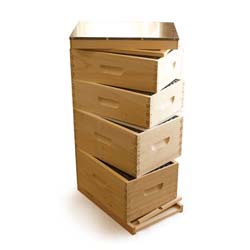The Amazing Biology of Winter Worker Bees
The worker bees you’d find in a hive in the hot days of summer are VERY different to those in winter. This isn’t just about behavior—it’s a complete physiological transformation. A summer worker bee lives just six weeks, wearing herself out in a frenzy of nursing and foraging. But a winter bee? She can live six months or more. Same species, same colony, but these winter bees are biological marvels, redesigned by evolution for one critical mission: survive the cold when no flowers bloom and keep the colony alive until spring returns.
It’s worth noting, though some regions have shorter and less intense winters, bee colonies in those areas will still have “winter bees” or diutinus bees (which means long-lived). This is because though the winters may not be as harsh as it is in other regions, there can still be cold snaps and most importantly, there won’t be anything for the bees to forage on, at least for some time.
The Tale of Two Bees
Summer worker bees are workaholics. From the moment they emerge, they’re on the clock—cleaning cells, feeding larvae, building comb, guarding the entrance, housekeeping duties like clearing out the dead, and finally, foraging for nectar, pollen, water and propolis. This relentless activity takes its toll. Their wings fray, their bodies wear down, and after about six weeks, they simply can’t keep going. That’s fine in summer—the queen is laying thousands of eggs, and replacement workers are emerging constantly.
Winter bees are survival specialists. They emerge in late summer and early fall with a completely different biological profile. They’re not built for frantic productivity; they’re built for endurance. These bees will spend months clustered together in the hive, eating stored honey, generating warmth, and waiting. Their bodies must last through the entire winter and into early spring—a feat that would be impossible for a summer bee.
What Makes Winter Bees Different
So what changes? The transformation is remarkable, and it happens at the cellular level.
- Enlarged fat bodies are the most critical difference. Winter bees develop significantly larger fat bodies—specialized organs that store proteins and fats. Think of a bear preparing for hibernation by building up fat reserves—but understand that’s just a helpful metaphor. Bees don’t hibernate; they stay active in the winter cluster. A better comparison might be monarch butterflies: the migratory generation develops larger fat reserves and lives eight to nine months, compared to just two to six weeks for summer monarchs. It’s nearly an exact parallel to what happens with honeybees.
- Examples of similar winter adaptations can be seen elsewhere in nature, including wood frogs, arctic ground squirrels, woolly bear caterpillars, and honeypot ants. Nature repeatedly solves the winter survival problem with enhanced energy storage.
- Vitellogenin is the secret weapon. This is a special longevity protein that protects winter bees against oxidative stress and aging. Summer bees have some vitellogenin, but winter bees produce it in much higher quantities. It’s part of what allows them to live so much longer—vitellogenin essentially slows down the aging process, protecting their cells from the damage that would normally accumulate over time.
- Reduced glands reflect changed priorities. Summer bees have well-developed hypopharyngeal glands that produce brood food for feeding larvae. Winter bees have smaller, less active versions of these glands. Why? Because they won’t be raising much brood during the winter months. Their bodies invest resources in survival, not reproduction.
- Behavioral shifts complete the package. Winter bees aren’t frantically flying from flower to flower. They’re patient, clustered, conserving energy. Their job is to shiver together to generate heat, rotate through the cluster so everyone gets a turn in the warm center, and carefully ration the stored honey that must last until spring.
When the Switch Happens
The colony begins producing winter bees in late summer and early fall. What triggers this isn’t for certain, but it’s believed to be the shorter days, cooler temperatures and reduced forage. But here’s what’s critical: timing and duration vary dramatically by location.
In Minnesota, winter bees may be the primary population in the hive from September through April—seven months of winter bees sustaining the colony. In Georgia, the transition might be much shorter and less distinct, with the colony ramping back up to spring activity much earlier. Your local climate determines when winter bees appear and how long they need to survive.
For a brief period in fall, both types of bees coexist in the colony. The last summer bees are dying off while the new winter bees are emerging and settling into their long-term survival role. This transition period is crucial—if something disrupts the colony during this time, there may not be enough winter bees to carry the colony through.
Why This Biology Matters for Survival
Winter bees must survive months without access to fresh pollen or nectar. While the colony has stored pollen and honey, the winter bees rely heavily on the fat reserves they built up in their bodies when they first emerged. Those reserves sustain them through the cold months.
When spring arrives, these same winter bees will produce the first spring brood, jumpstarting the colony’s growth for the new season. They’re dual-purpose marvels—survive winter AND restart the colony.
Here’s the vulnerability: winter bees that are damaged or weakened can’t fulfill their mission. Bees harmed by varroa mites or emerging from poorly nourished colonies may not develop proper fat reserves. They won’t make it through winter—and neither will their colony. We’ll explore this critical connection in later articles.
The bottom line? Winter bees represent one of nature’s most elegant solutions to an impossible problem: how to keep a cold-blooded insect colony alive through freezing temperatures when there’s nothing to eat and nowhere to go. The precision of this biological transformation—the colony somehow “knowing” when to switch from producing summer bees to winter bees—is nothing short of amazing.
